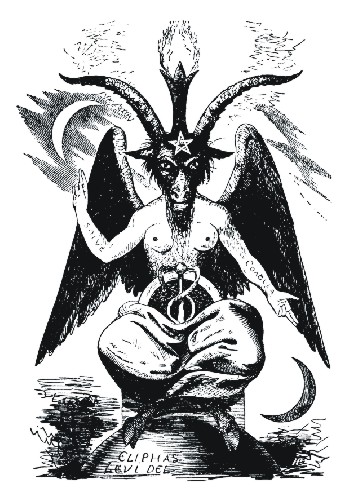 |
THE ELIPHAS LEVI BAPHOMET DRAWING
and
HOW THE CHURCH CREATED THE IMAGE OF THE
DEVIL.
by
Frater Caprius Nigellus |
The rise of the early Christian church was marked by a battle to
individualise itself by usurping and suppressing pantheistic ethos of all peasant cultures
with which it came into contact. The purpose of pantheism is not idolatry (as the church
has continually misinformed us) but a method of representing the method of nature.
At
the top of the scale were the God and Goddess images, which were simply human most perfect
form. These were icons to which peasants ASPIRE. At the 'bottom' the icons used were those
things animate and inanimate, which encapsulated or symbolised elemental or physical
forces such as fertility of animals and crops, these were things upon which the
populations well being were dependant.
In
the rustic communities, which then existed, their reverence for animals and birds went
back into prehistory and all organised pagan ceremonies (and later, monotheistic ones)
were just developments or dramatisations of these ancient rustic perceptions and rituals,
supposedly enacted for the benefit of the community. An example of this might be the
sacrifice of a pig from the flock to the god
that made pigs grow big This was simply an extension of the development of feudalism
where the head of the tribe took a percentage of the peasants stock or food.
Animals
were often used by pagans as Totems. The symbols carved into Totem poles by Native
American Indians were not 'devils', but simply respect for the spirits, souls and dignity
of animals. Even so they were still considered 'devils' by the early Christian
missionaries to America.
As
early Christianity developed, for the first few hundred years like other religions it adapted much of the pagan
worldview to suit it's purpose. e.g. the myth of the Christ god was virtually a direct
adaptation of the Mithraic religion.
Christianity
also had to compromise with local habits and customs, which is why many Anglo-Saxon
churches had two altars; one for the Christians and one for the Pagans that also
worshipped there. This was how the Christian missionaries to Britain surreptitiously
commandeered exclusively for their own use the sacred sites, which Pagans had used in
pre-history and continued with the adaptation of Pagan festivals.
When
Christianity was weak it conjoined with what was expected tradition. When it became
powerful enough to dictate what its followers should think and do, it soon began to divest
itself of non-Christian pantheistic symbols, suppressing any Pagan content in festivals by
firstly ascribing evil, anti-social, destructive, immoral and malevolent influences to them. Thereby
establishing misdirection to enable the victimisation and suppression of peasants who
chose not to conform.
Admissions
and inventions extracted from pantheists via torture or punishment were manipulated into
further corroboration of the previously invented propaganda and the demonization of Witchcraft was developed progressively by the
Church just as the mythology of Satanic Abuse is being developed and used against
Neo-Pagans and other non-conformists today.
Goats were a terribly important part of most tribal
cultures back into prehistory. They were an indigenous resource, which was plentiful
across Europe. Goats could survive on rough pasture; they provided all that the tribe
needed in the way of food, clothing, thread, wool, milk, horn etc. Goat milk could even be
used to succour human babies. This is still true today in many rustic parts of the
Mediterranean countries where goat herders continue husbandry, which is thousands of years
old.
In ancient times goats were revered and their image found its
way into virtually every Pagan pantheon. The most frequent symbol of male dominance was
horns, usually those of a goat, but sometimes also that of a bull or ram. The Church
became fixated upon any image with horns as a symbol of paganism - the religion they
wished to replace. This was particularly the case in relation to Judaism (from whence most
early Christians were converted) for in the Jewish religion the four elemental animals
whose Image support heaven (and the altar in the Synagogue) comprise four animals,
including a Horned Bull. The altar itself has, by tradition, horns as a decoration on each
corner, and of course the goat was sacred to the Old Testament angel Azaxel who was the
'Messenger of the Lord' and who was sent to Earth each Atonement Day to take away the
Scapegoat and purify Mankind's sins. Anti-Semitism made the link with Sin, Goat and Jew in
a different way and in Wade Baskin's Dictionary of Sorcerery (1972) he writes: 'The goat
appears in mediaeval folklore as the symbol of Judaism and the Jewish God. The goat's
beard or goatee, a supposedly characteristic feature of the Jewish physiognomy, was also
considered to be a physical token of the Jew's Satanism.'
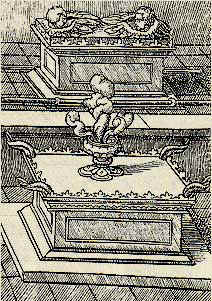
Four Horned Altar from Antwerp Bible 1526 |
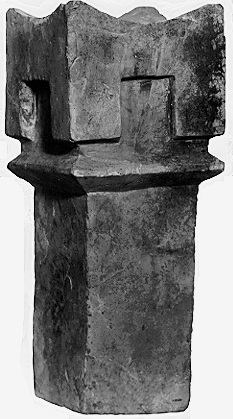
Four Horned incense Altar from Megiddo |
It is true that most of the 'devil' images in demonology were
created during a time when the Jews were being hounded and persecuted throughout Christian
controlled Europe. The religiously pious King
Edward I ordered the expulsion of every Jew in England following several decades of
Jew-bashing which had been started by rumours of Jews sacrificing children at their
rituals. This is the same kind of scare tactic that was repeated by Satan Hunters in the
social services in 1989. Massacres of Jews occurred in London and York where some 400 were
burned to death en-masse at Clifford's Tower. It is estimated that around 16,000 English
Jews were dispossessed. Edward then promptly confiscated all Jewish property in order to
bale out his ailing treasury.
Throughout the world indigenous religions all used a horned
animal of some kind to represent power, virility, strength, courage and plenty, and each
one was discredited in turn as being heretical or Satanic when the Christian war machine
overpowered that society and then tried to suppress any religious competition.
| To give you some idea of how
prevalent and benign the Goat icon was I quote from Barbara Walker in her 'Woman's
Dictionary of Symbols and Sacred Objects' in which she says: 'Sacrifices of goats
identified with men or gods were common in ancient Greece. The oldest Athenian religious
festival was Apaturia, which featured Dionysus in a black goatskin. In Rome the
sacrificial god of the Mamuralia was a man dressed in a goatskin who was lead through the
streets and flogged as a symbol of atonement. The goat people mythologized as satyrs and
fauns were originally men identified with the sacred goats, on whose images the mediaeval
goat-horned goat-hoofed devils were modelled. Scandinavians were admonished by their
Christian overlords right up to the seventeenth century for their pagan 'goat games'
associated with religious holidays and yet these symbols persist. To this day
Scandinavians make a Yule Goat out of straw to serve as a year-end sacrifice. Folk dance
patterns have absorbed the ancient 'caper' which literally means 'goat dance' from the
Latin word for goat. The same source also gave us caprice (capriccio) and Capricorn and
the Isle of Capri was once dedicated to the goat lord. |
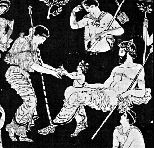
Dionysus |
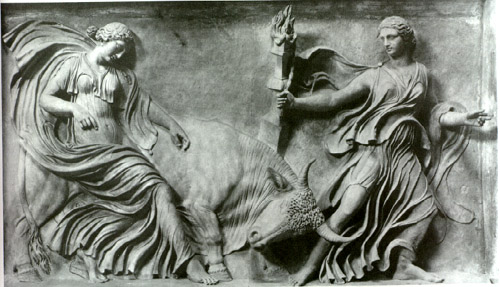
Dionysus as a Bull |
In Dr. Brewer's 'Dictionary of Phrase and Fable' from 1870 he
says: The goat is possibly the oldest domesticated animal after the dog. It is a
sacrificial animal and was sacred to the Sumerian god Marduk and also to Artemis. In
Greece the goat was an attribute of Silvanus and Dionysus. Goats were also sacrificed to
Faunnus. The Teutonic Thor had a chariot drawn by goats which were sacred to him. His goat
Heidrum supplied mead which was the drink of the Gods. The Vedic Agni god of fire and
creative heat rides a goat. The Chinese have a goat spirit that is a transcendent of the
star Fan-Yin and the Mongolians also have their own version of this same god.
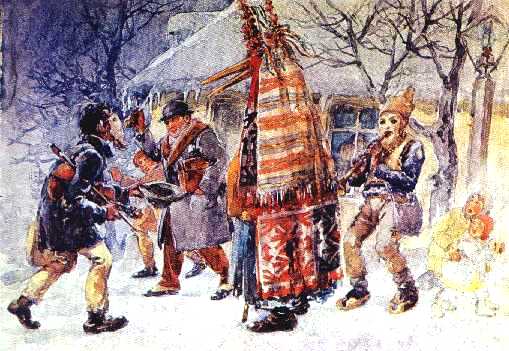
Traditional Romanian goat mask folk dance |
Sir James Fraser adds that in Prussia the
Corn Spirit anciently appeared in the form of a goat and he also points out that Dionysus
(who is celebrated with the Black Goat Skin Rite) was actually a Corn Deity. It is worth
mentioning that a goat may seem to be a strange choice for a corn deity but there was in
fact an intimate connection between corn crops, fodder and goats. In Lower Bavaria it is
said of the man who cuts the last corn that he has the 'corn goat' or 'oat goat' depending
on which crop is being gathered. This compares with the British corn sheaf spirit which is
made into a doll or poppet (a representation of the pagan goddess figure of Cerres) and
its Christian counterpart the corn cross. |
Fraser also tells us that in Scandinavia around 1920 they still
made model goats out of corn to sacrifice to their Pagan gods. In Hanover the harvest
festival begins with the bringing in of the 'Harvest Goat' where the woman who bound the
last sheaf is wrapped in straw, crowned with a wreath and taken to the village where a
dance takes place round her.
In Grenoble a live goat is adorned with flowers and ribbons and
is allowed to run about in the cornfield before the harvest begins. When it is caught it
is slaughtered and the goats meat forms the main dish at the Harvest Supper. On the same
day the skin from the sacrificed goat is made into a cloak which the farmer must wear at
harvest time to bring good fortune.
At Wurttemberg, the effigy of a goat is made out of the last
bundle of corn and the man who cuts the last corn must carry the goat to the barn of a
neighbour who is still threshing for good luck.
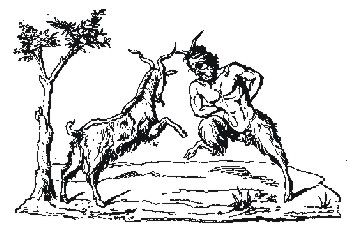 |
All these remnants of the Black Goat Skin
rite still existed or were remembered in central Europe in the early part of the 20th
century. It is testimony to the importance of these pagan rites that they had survived,
even if in a fractured form, throughout the witch hunting programmes even when their
religious pagan meaning has become somewhat lost. Other reference to ancient rites
involving goats exists in Modern times throughout Europe, including the 'Cripple Goat'
ceremony on the Isle of Skye. |
The original Goat of Mendes was sacrificed at the city of Mendes
in an ancient Egyptian ritual to cleanse the sins of the population and to renew the
beneficial forces for the coming year. But this merely followed on from its use as a
sacred animal in Sumerian and then Babylonian religions. Just as the Jews (and then the
Christians) took their myths about creation from the Sumerian and Babylonian religions,
the idea of the risen Sun God / Ra / Zeus / Dionysus / Mithra or Christ figure was also a
development of earlier religious beliefs and so it was no accident that the Goat of Mendes
found itself represented as the Scape Goat in the Jewish religion after it appeared in the
Egyptian liturgy. The problem began when the Christian Church decided to monopolise ALL
religious belief and suppress anything that went before which was not seen by them as
strictly Christian.
The claims made about Witches (which meant those who adhered to
the old religion or old ways - lets not forget that the word Pagan is Latin for 'Rustic')
trafficking with a devil-goat are examples of the way that the twisted fundamentalist
mindset re-interprets things in a darker dimension in order to grasp control of society
and to terrorise the masses. At the time of the Witch hunts literally millions of people
were either goat herders or had connections with goats. It is the modern day equivalent of
identifying Satanists as people who drive cars! In rural society EVERYONE had become a
suspect.
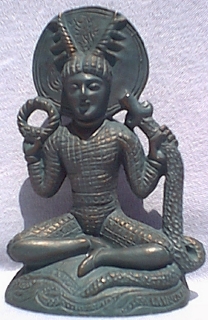
Cernunnos |
Witches or Pagans never worshiped a devil.
There was no devil figure in their cosmology. The Pagan Celts sometimes used a horned
animal to represent maleness, virility, power, courage and strength. Just as the Vikings
used horns as emblems. At other times and elsewhere in Britain other tribes used different
horned animals to represent these things. In Southern England it was a stag (Herne the
Hunter) and in other parts of Europe Cernuous was the stag deity. Sometimes another animal
without horns would be felt to be more appropriate, such as the White Horse of Uffington.
The lineage of all these animal totems can be clearly seen in the prehistoric cave
paintings that our ancestors have left for us. To the twisted fundamentalist Christians of
the time EVERYTHING with horns was a reminder of the great pagan civilisations of the past
and had to be eradicated if they were to succeed. |
The key factor in the supposed witches rites of the time is it
term that is repeatedly given by commentators on Witch Trials that 'Witches were reputed
to worship the Devil in the form of a goat.' Indeed in many trials victims gave testimony
under torture that they ' worshiped the Devil in the FORM of a goat'. Not that the Devil
actually existed or actually manifested, nor that the goat was anything other than a goat.
In short, the victims were peasants following the old ways and it was their inquisitors
who turned the scape-goat into the Christian devil for only later did the twisted
demonologists add the imagery of the half-man, half-goat figure with a pointed tail to
equation and then begin asking questions about 'him' under torture to get confirmation.
ry of a half-man the equat
The original meanings and purpose of Pagan icons were quite
clear and had been tolerated by the Christian Church for centuries. The horned goats,
bulls and rams were not 'worshiped' in any way by the religious orthodoxies of the time.
The goats, bulls, stags etc. were merely involved in ceremonies when it was relevant to
the life styles of the people. These ancient rites were reinterpreted with an evil or
immoral context by the church in order to justify the genocide of millions of innocent
peasants, whose only crime was to follow the old folk tradition.
Complete eradication of these horned icons was impossible, as
they existed not only in the minds of the masses, but as realities in their everyday
lives. Therefore the Catholic Church had to compromise and allowed many of the old Gods
and icons to meld with their own. For instance the popular icon of the Mary cradling Jesus
is a direct lift from statues and paintings of the Ancient Egyptian goddess Isis who is
shown cradling the baby Horus two thousand years before the Mary legend was created.
Soon it was not long before anything that did not fit with the
Christian cosmology was attributed to the 'devil figure' even though there never was an
authentic 'devil' image because no pre-Christian religion ever had a 'devil' in its
cosmology. The first likenesses of the devil were produced in the late 15th century as a
by-product of the witch-hunts.
Senseless and irrational admissions about supposed meetings of
witches were forced from the accused via torture. The ironic reasoning behind the
compulsory use of torture was that it was said to be the only thing that would guarantee
the accused spoke the truth! In reality the millions of people who were subjected to the
most agonising torture imaginable invented anything they thought might stop the unbearable
pain.
| The icon which most people now believe to
be a depiction of the devil is Eliphas Levi's 'Goat of Mendes drawing.' This is a
relatively modern image, created and drawn by Levi who was a knowledgeable and influential
French Quabbalistic Magician whose work in the late 19th Century is said to have started
the modern occult revival. In his book 'Transcendental Magic' from 1860 Levi (who had been
a Roman Catholic priest) explains that his image symbolises the position of non ascended /
non aware humans, linked more to their bestial nature than their god like consciousness.
The animal kameas chosen to represent the elemental forces which create our environment. |
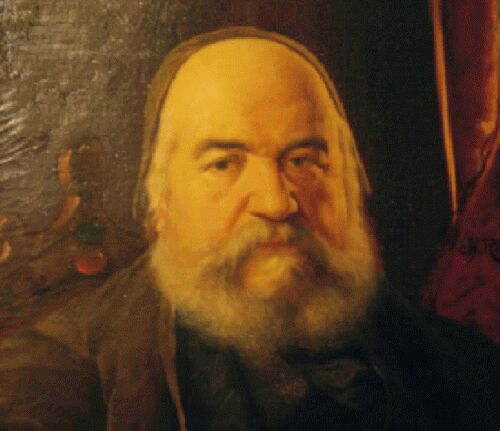
Eliphas Levi |
The Goat sits in water and bears a fiery torch of knowledge
between its horns. One arm points to Heaven bearing the inscription' Solve' or' to set
free' and one to Earth bearing the legend 'Coagula or (Coagulation / Density / to impede).
This image includes the waxing and waning moons and is of Alchemical importance. It is
also said to reflect the teachings of the Templars about gnosis, the ability of man to
know God directly once he has overcome his animal self. Although the Knights Templar group
was an off shoot of the Catholic church and spent hundreds of years crusading against the
Moslems (and therefore had nothing to do with paganism) the group fell into disfavour and
was suppressed in 1320 following information given by renegade members about supposed
heretical practices.
The persecution of the Templars occurred just as the European
witch-hunts were gathering pace and so evidence about their supposed devilish practices
was incorporated into the developing demonology. The Templars named their icon (of which
no drawing, painting or effigy has ever been found) - Baphomet. Levi's drawing was an
attempt to give form to this idea 600 years after the event. The image is often described
as the 'Goat of Mendes', 'The Witches God' or 'Satan'. None of these is correct. Basically
Levi’s drawing represents the animal nature of mankind, which the thinking person has
to transcend in order to develop.
One thing is clear; Levi’s image (on which Dennis Wheatly
and Hammer Horror films built their fortunes) is NOT a devil figure and was never meant to
be. For Levi's model is a Hermaphrodite. In particular, it has breasts. The lack of
breasts is a give away for fraudulent versions. Film depictions usually show the 'devil'
as being all male and thereby they miss the symbolism entirely.
Levi's figure has nothing to do with witchcraft for it is based
on Judaic and Quabbalistic philosophies which are not the same as the use of the goat in
Paganism. It is plain that the use of the Goat as a symbol in Paganism the world over is
related to its relevance in the day-to-day mundane life of the locality, not to any
religious belief in a Devilish deity. As with all knowledge, the truth if any one thing
resides in its opposites. The Christian Missionaries have lied to the people for thousands
of years and controlled their minds and actions in the process. There was never any Devil
other than in their own warped imaginations and any act of Devilry was solely down to
them.
Return to Home Page










